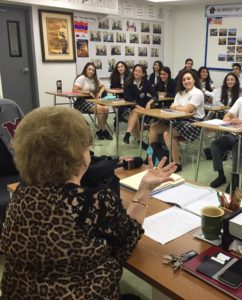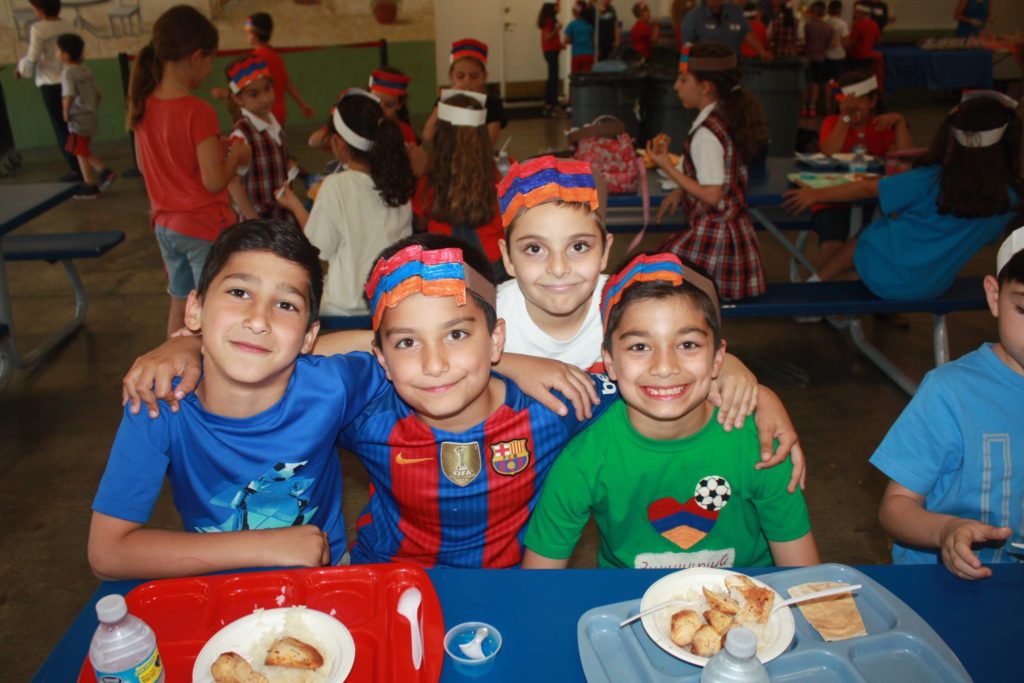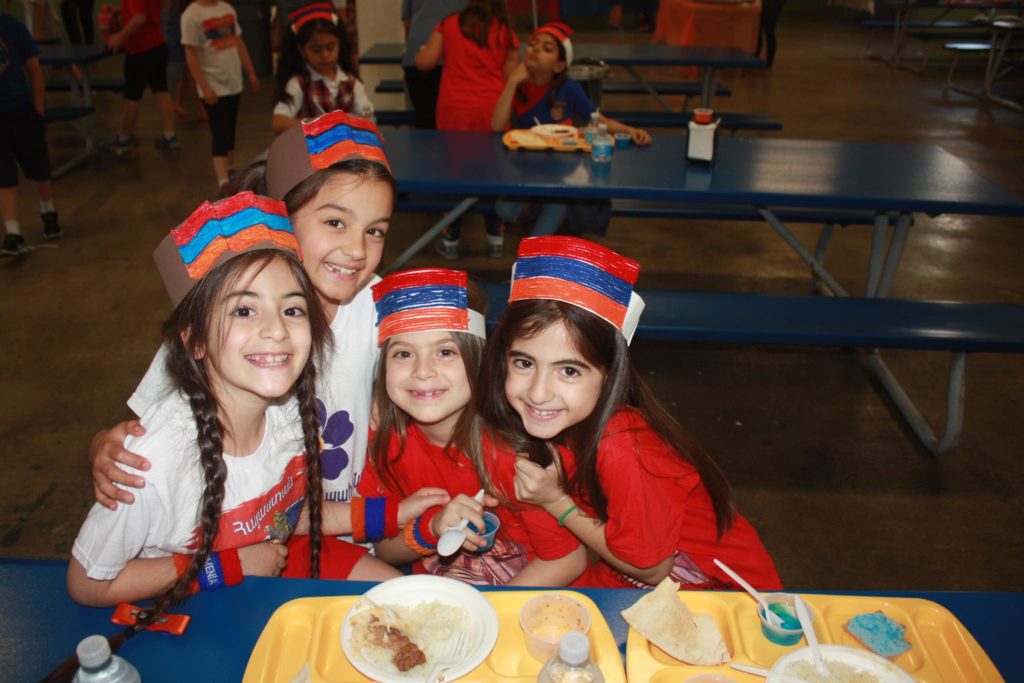
In a classroom decorated with ancient and modern maps and photos of students in front of statues and monuments, restless high school juniors dressed in navy and plaid uniforms are seated at their desks trying to follow along with their teacher’s lesson of the day. Hanging overhead is a tricolor flag—red, blue and orange. This is a daily Armenian language class at AGBU Manoukian High School in Pasadena, California.
“What is the first thing Armenians build when they migrate to a new place?” Ms. Lora Kuyumjian, a 40-year Armenian teacher, proudly asked her class.
“Schools and churches,” the students responded, almost mechanically.

Armenian school students living in the Diaspora say this piece of knowledge is passed onto them from day one. The concept of cultural preservation is deeply ingrained in these young Armenian Americans by their families and by the schools.
In large part as a result of the Armenian Genocide, Armenians are spread out in almost every corner of the world. There are more Armenians living outside of Armenia, than in the country itself. The result: Armenian schools have been established in many communities inhabited by Diaspora Armenians.
Armine Movsisyan, director of curriculum and instruction at the Los Angeles Unified School District, explained that the attempt to wipe out someone’s identity makes it all the more important for that person, or that group of people, to maintain who they are. That is part of why cultural identity and ethnic background, she said, are really important to Armenians – because it was challenged.
“not just surviving, but thriving is such an essential part of our story”
“As a culture who faced the reality of genocide – getting rid of all members of this ethnic group – I think that not just surviving, but thriving is such an essential part of our story,” said Movsisyan, who was previously the principal at AGBU Manoukian.
As a people historically persecuted for their religion and ethnicity, who were victim to genocide and who are now one of the few communities that have a large diaspora – a homeland that they live outside of – Armenians outside of Armenia cling to their identity, Movsisyan explained.
There are over 171,000 native Armenian speakers living in Los Angeles County, making it one of the largest Armenian communities living outside of Armenia. Consequently, there are 14 Armenian day schools throughout Southern California with over 4,300 students.

In such a richly diverse country like the United States, ethnically homogenous schools might seem odd for those outside the community. However, the general goal of these Armenian schools is not to promote an atmosphere of xenophobia – far from it.
“The Armenian heritage is so endangered. Armenians are so few to begin with,” said Deeown Shaverdian, an Armenian school alumnus and current supervision advisor at Chamlian Armenian School in Glendale. “With the melting pot that is the United States, more and more here are forgetting the language, the culture. I have a fear that we will cease to exist.”
Students, parents, alumni and faculty say the main appeals of Armenian schools are the safe environment, the preservation of culture, language and Armenian identity and the fear of assimilation as a post-genocidal diasporan group.
Juniors at AGBU Manoukian expressed that it can be difficult to grow up in what can feel like a cultural echo chamber, surrounded by people who are, in some respects, the same. Yet, every single student in the room, including the disinterested slackers and the rebellious class clowns in the back, said they too would send their own children to Armenian school.
Vana Yepremian, an eighth-grader at Chamlian, said she would send her future children to Armenian school because she believes it’s important that future generations stay Armenian, know the culture and speak the language.
“It’s a good chance to have as a young Armenian person to learn more about your own culture, who you are and what your past is,” she said. “It’s important to know what has happened before I was born.”
The Pull
 Families send their children to Armenian schools for several reasons. The primary reason is the preservation of Armenian identity.
Families send their children to Armenian schools for several reasons. The primary reason is the preservation of Armenian identity.
“They can learn to appreciate their heritage, culture and language,” said Aline Yepremian, who has three daughters in Armenian school.
Yepremian explains she wants her children to have that opportunity because she didn’t. Growing up in Canada, there weren’t any local, daily Armenian schools for her and her siblings.
Ana Sirabionian, an alumnus of Pilibos Armenian School in Hollywood and a teacher specialist at Chamlian, explained that preserving facets of Armenian-ness and passing them on to future generations who live in the Diaspora can be difficult.
“When people are forced to live outside of their country, they can easily just eventually disappear, forget their language, forget their culture. To us, as Armenians, it’s really important that that doesn’t happen,” Sirabionian said.
“The Armenian heritage is so endangered…I have a fear that we will cease to exist.”
The fear of losing the Armenian identity stems, for many diasporans, from the Armenian Genocide, Movsisyan explained. The Ottoman Empire’s attempt to annihilate the Armenian race has left a trans-generational trauma in generations of Armenians.
“When someone tries to take something away from you, your identity, generations are affected by that psychology,” said Movsisyan.
Talar Kakilian, who transferred from a public school to Sahag Mesrob Armenian Christian School in Pasadena in the seventh grade, explained that Armenian schools gave her a clear sense of who she was, who she wanted to be and where she wanted to go.
“Once I got to Armenian school and I started learning about our history in a deeper way, reading our literature, reciting poetry and performing music that was composed by Armenian composers, it really solidified that identity that my parents had worked so hard to foster in me,” she said. “It gave me a clear view of who I was as a person and how that ethnic identity has allowed me to become who I am today.”
Armenian schools can offer a safe environment for students to feel comfortable and to grow in.
Tenny Kizirian, an alumnus of Chamlian Armenian School, now sends her two sons there.
“I wanted them to have the social environment that I had,” she said. “The friendships and bonds you create there are truly lifelong.”
Kizirian explained that as a parent, she feels a sense of assurance knowing who her children’s friends and their families are.
Sirabionian echoed the sentiment, saying, “We knew each other’s families and grew up together. It’s really like family.”
Lack of Diversity:
Armenian school administrators are conscious of their lack of diversity, Sirabionian said.
“Some people might feel like it’s xenophobic: Armenians just want to be with other Armenians; they have their own schools,” said Sirabionian. “But that’s not what it’s about. It’s about keeping a culture alive that’s otherwise dying.”
Alique Cherchian, who attended Ari Guiragos Minassian School in Santa Ana, entered public school in seventh grade. She said that once she left the sheltered Armenian school environment, or the “bubble”, she had a grounded sense of her identity and her roots.
“As long as you live outside of the homeland, the time you have to be in such a grounded environment like this is very limited,” she said.
Although Cherchian said she would definitely send her children to Armenian school, she would also like for them to experience public school, as she did.
“I want them to learn to educate their peers and others on history that is unfortunately not taught enough in the public school system, if taught at all,” she said. “I would want them to experience that empowerment, but at the same time learn that there are so many other students who come from very different backgrounds. Understanding that Armenian politics and history is not the center of the world is something I want my kids to learn and understand.”
The ‘sheltered’ Armenian school environment can be like a safe zone where students’ ideas about the world and ‘others’ go unchallenged.
“In an increasingly globalized society, that would be an issue. You’re going to be exposed to different types of people and mentalities all the time,” Shaverdian said. “Knowing how to connect with them and communicate with them is vitally important.”
Many alumni and parents expressed the desire for students to have a more diverse experience. However, for many families, the cultural preservation aspect of the Armenian schools outweighs the lack of diversity.
“For me, when you weigh what is more important, as a family we’ve decided the Armenian aspect is,” said Yepremian. She adds, however, that she does wish her daughters were exposed to diversity earlier.
Armenian school students share common ground when it comes to language and culture. But experts say it’s much more than that.
“We are unified linguistically,” Myrna Douzjian, professor of Armenian language and literature at the University of California, Berkeley, said. “Our cultural experiences that inform our ideas about our identity might be very different.”
 Douzjian, who attended Pilibos, explained there are many different types of Armenians at these schools. Many of these families come from Iran, Lebanon, Syria, Armenia, Iraq and elsewhere. Some students are born in the U.S. and have immigrant parents or grandparents, or are, themselves, immigrants. There are also students with mixed families, children of mixed marriages and so on, she described.
Douzjian, who attended Pilibos, explained there are many different types of Armenians at these schools. Many of these families come from Iran, Lebanon, Syria, Armenia, Iraq and elsewhere. Some students are born in the U.S. and have immigrant parents or grandparents, or are, themselves, immigrants. There are also students with mixed families, children of mixed marriages and so on, she described.
“Talking about differences enriches one’s sense of self and education,” Douzjian added.
“The strong connection to Armenian identity can spark an interest in learning about other cultures,” said Alik Yepremian, an alumna of Armenian schools who is now a sophomore at Loyola Marymount University.
“It’s kind of hard to relate to others because I’ve ever only known Armenians,” she said. “But I’ve realized the people I’ve become friends with (in college) are also really connected to their culture and their background. That’s where it becomes easier because we have that strong connection to who we are.”
Having only known Armenians for most of their young life and having a sense of family in a tight-knit community, can make it difficult to form relationships with others.
“I felt so confident with friends I already had, that I didn’t feel the need to look for other friends in college,” Sirabionian said. “But now, I’m more interested in people of different backgrounds and upbringings because I didn’t get to experience much difference growing up.”
That being said, there is more to a person than their Armenian-ness, she added.
It’s not for everyone
Not everyone can afford to send their children to an Armenian private school.
Teni Bazikyan, a recent graduate from University of California, Berkeley, came to the United States from Iran when she was 13. While living in Iran, she attended Armenian private school until sixth grade. When she and her family moved to Glendale, California, she no longer had that option due to financial restraints.
“It was expensive for us. We just got here, my parents were looking for jobs, we were trying to settle,” Bazikyan said.

Still, living in Glendale, a city with a large Armenian population, most of her friends in public school were Armenian. This was a subconscious decision, she said, because she related to Armenians more easily. As for those outside her Armenian circle of friends (the odars as Armenians say), Bazikyan made a surprising discovery.
“By explaining ourselves and our identities to non-Armenians, we became more Armenian because they were constantly questioning things we never questioned about ourselves,” she said. “They sort of made me more Armenian.”
Vanuhi Vartanian, who was born in Armenia and moved to Glendale when she was 4 years old, said she noticed most of her friends who attended Armenian schools are not first-generation. Their parents have lived in the U.S. for some time and are better established and can afford to pay private school tuition, she said, as opposed to those who are new to America like her own family.
“If my parents could at the time, they would have enrolled me in Armenian school,” Vartanian said. “I think many parents who come from Armenia would love to do that but they can’t afford it when they first move here.”
Vartanian, who attended public schools throughout her life and recently graduated from UC Berkeley, believes that, in a way, it was a disadvantage for her.
“Whenever I started taking Armenian classes at UC Berkeley, the students who had attended Armenian private schools read a lot faster, wrote a lot more accurately, were well-versed and could get through a conversation without saying ‘um’ and they knew all these big vocabulary words, something that I didn’t get to practice too often at home,” Vartanian explained.
However, she did attend Saturday school and free after-school Armenian classes at her public elementary school.
Armenian is the second most spoken primary language for Los Angeles Unified School District (LAUSD) students who are also English speakers. As a result, some public schools have begun to offer classes in Armenian. The LAUSD and the Glendale Unified School District have launched dual-immersion programs, where students learn and speak Armenian in some of their classes.
With public schools beginning to offer Armenian language classes, families who cannot afford an Armenian school education for their children can still have the option to learn Armenian in school, Vartanian said.
Last Bell
For the 11th graders in the Armenian class at AGBU Manoukian, being surrounded by Armenians doesn’t mean they’re all one and the same.
Michael Pratt, head of school at AGBU Manoukian, who is not Armenian, agrees.
“I can see us having a great ethnically, racially, politically tight-wrapped heterogeneous student body where everybody’s difference was the most valuable thing,” he said. “Not everybody’s sameness.”
Sareen Habeshian attended Chamlian Armenian School and AGBU Vatche and Tamar Manoukian High School.



It’s a sad fact that the offspring of native Armenians do not appreciate nor care for Armenian schools. A very small percentage actually send their kids to these schools. They take being Armenian for granted. The chronic lack of funding for these schools can be easily overcome if 90% of the Armenian population enrolled just 10% of their children. But sadly, being Armenian by name only is apparently enough for the native born.
A very interesting and enlightening article. The author has done her homework.
Great job writing such a detailed article, Sareen. Very well done!
Armenians who do not attend private Armenian school for whatever reason is not the only cause for concern for extinction of the Armenian culture. I believe the critical issue is many Armenians, including in my family, some who did attend Armenian school, end up marrying non-Armenians… that will speed up the extinction. Sorry this is not the politically correct thing to say, but if Armenians want our people to survive, we need to marry and start families with Armenians. There is also a stigma against Armenians, thanks to the last immigration wave, and many Armenians pretend not to be Armenian and care not to learn about their roots especially if they are born here. In addition to schooling, there is so much more to do to preserve our culture.
There may be 100-150 Armenians of appropriate age for marriage in a given American city (other than Los Angeles/Glendale). Of those, eliminate the ones who are not single. Of the remainder, eliminate the ones who do not have their life together (no job, no independence, etc.). Of the remainder, eliminate the ones whom you do not find physically attractive or who do not find you physically attractive. Of the remainder, eliminate the ones whose personalities you clearly do not like and who clearly do not like your personality.
That leaves, what, 2 or 3 people? And we’re supposed to trick ourselves, convince ourselves, that we are in love with one of them? It sounds like a sure-fire recipe for divorce or a miserable marriage, and any children born to such a marriage will resent their parents. And, when these children become old enough to realize that the reason they grew up in a broken family was for the “Armenian Cause,” they will resent their Armenian identity too.
Every person must decide how he or she will contribute to Armenian life. Today there are many ways to do so besides sacrificing your own personal happiness by tricking yourself into believing that you’re in love with one of the few available Armenian people in your town. With the Internet and globalization, anybody can learn Armenian quickly, or do business in or volunteer in Armenia. It is much easier to avoid assimilation today than it was 20 or 30 years ago, regardless of the ethnicity of your wife/husband or father/mother.
To grow the Armenian population it is essential that we start accepting others into the fold. That is how other nationalities have grown in leaps and bounds. What you are proposing is counter productive and detrimental to our survival. Armenizing others will exponentially grow our numbers and ensure survivability.
LOL–I married an Armenian to make my parents happy. Then, they were against my divorce. As a result, they did not emotionally support my decision to divorce him, so I stayed stuck in an unhappy marriage. He didn’t even want children from day one; essentially I married a liar. When, I finally divorced him, it was too late to have a child of my own. So, DON’T marry an Armenian. It’s not worth it. Just teach your children Armenian, no matter who you marry. That’s a better thing to do.
Well that’s a blanket statement “DON’T marry an Armenian. It’s not worth it”. Just because you were unhappy doesn’t mean everyone is to. Perhaps you were the miserable party. Your anger and attitude tells a lot.
I’m sorry that this happened to you.